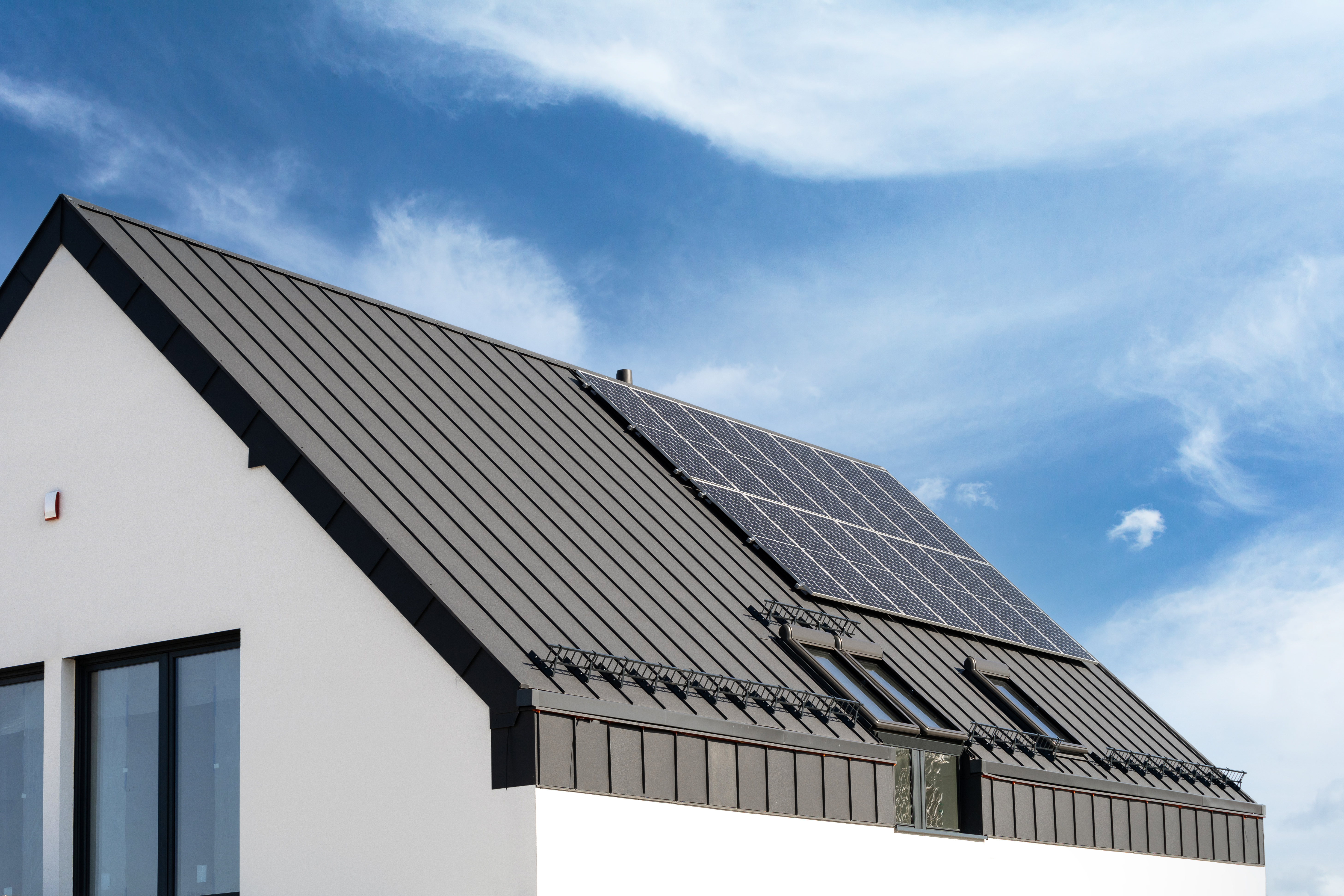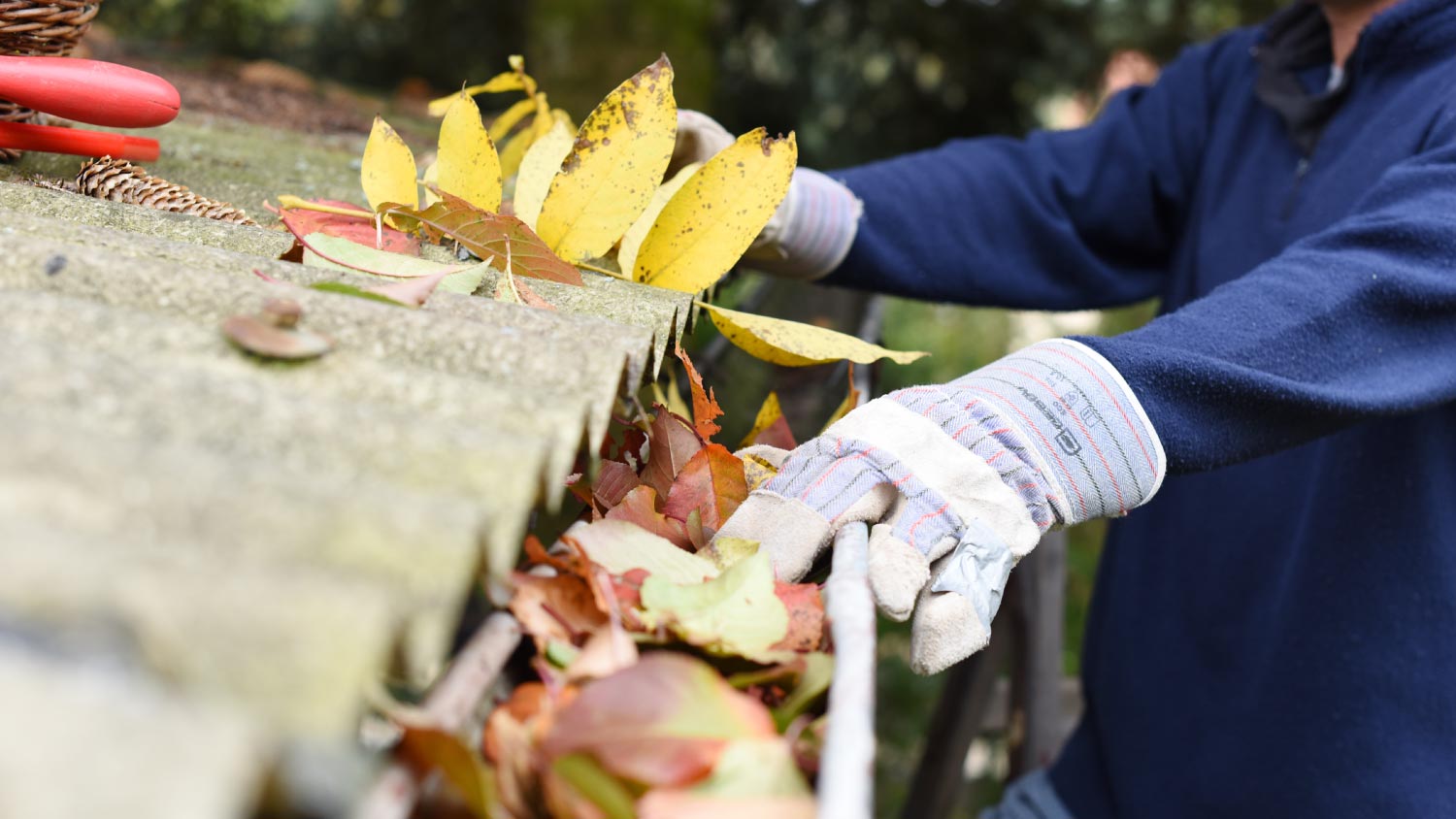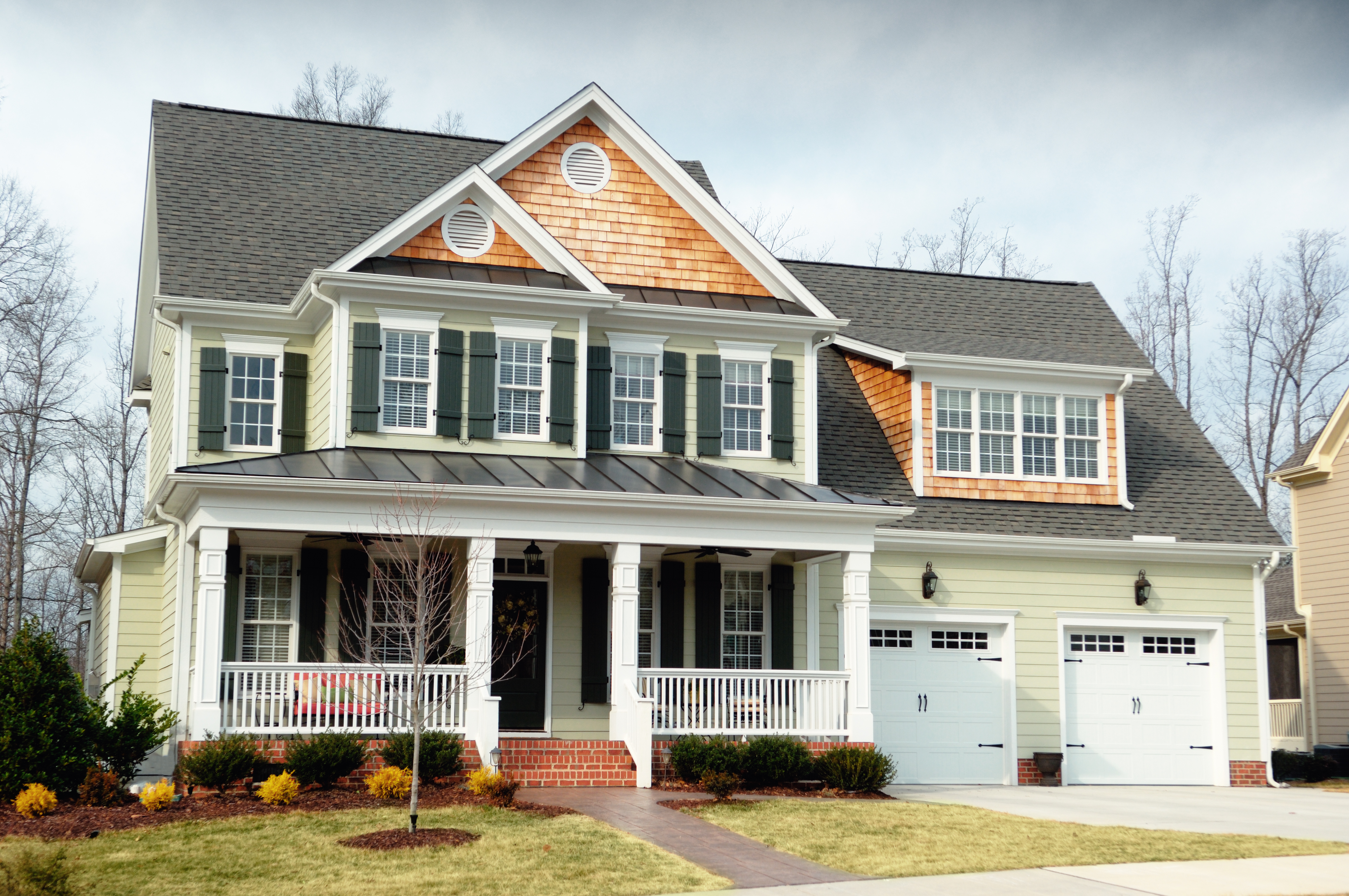
A metal roof can defend your home against Ohio’s varying weather conditions. Learn how much a metal roof costs in Columbus, OH.
Find out whether it’s algae or mold throwing a party on your shingles


Mold can be a health hazard, while algae are a cosmetic issue.
Algae grow in areas with access to sunlight and moisture.
Mold thrives in humid areas with access to wood.
Remove them both with a soft wash and bleach and water solution.
A soft wash for a roof costs $0.30 to $0.60 per square foot.
Ever looked at your roof when coming home and thought those black streaks were mold? If you did, you’re not alone. It turns out it’s the first impression for many homeowners. They frequently confuse roof algae and mold, but while they’re both an eyesore, they’re not the same.
This guide will explain how you can spot the difference between algae and mold on your roof, how to remove and prevent them, and when you should call a pro.
Mold and algae are easy to confuse, and people often use the words interchangeably. However, they are completely different types of living material. Mold is a fungus that survives off of nutrients in and on building materials, thriving on the destruction of those materials, while algae are closer to plantlife; they use photosynthesis to create food, along with feeding on organic matter on home siding and the limestone in shingles rather than the products themselves.
While they can both be ugly and harmful to your roof over time, roof algae rarely makes people sick, while mold can have an impact on human health, and it’s much more likely to cause damage to homes and spread in a shorter amount of time. Where they show up is different, too—algae are more likely to grow on roofs, while mold is more likely to grow inside homes or tucked under building materials.
It’s also easy to conflate mildew with mold and algae. Mildew is a type of fungus or mold, and many people use the word to generically refer to mold, especially mold or fungus growth that is black, dry, flat, or spotted. It can be found on roofs, but mildew most commonly flourishes inside homes in areas with high moisture levels, such as showers, bathrooms, windowsills, and basements.
| Type of Difference | Mold | Algae |
|---|---|---|
| Roofing Impacts | Minimal, subsurface | Shingle damage |
| Human Health Impacts | Mild to severe | Very rarely |
| Growing Conditions | Dark, damp, and moist | Sunny, bright, and humid |
| Color | Generally black but can be any color | Shades of green, blue-green, or brown |
| Food Source | Organic material | Photosynthesis |
| Ease of Removal | Hard to remove | Easy to remove |
Color is one of the best ways to tell if what you see on your roof is algae or mold.
The most common type of roof algae (Gloeocapsa magma) is a moss-like cyanobacteria with a blue-green hue. Algae are almost always green, but neutral shades can blend in with roofing; it’s often first identifiable by the black streaks it leaves on roofing and siding as it eats organic materials.
Mold can be almost any color, but it’s most often dark gray to black (although brown and green are common, too) and usually shows up in patches that grow quickly. Some types can also appear to be slimy.

Mold and algae grow in different places, with algae preferring more exposed locations and mold preferring the underside of roofing and the inside of buildings.
Algae love humid climates and bright places because it grows through photosynthesis, so it doesn’t like to live in buildings because it needs sunlight and water. For this reason, it tends to grow on roofs, gutters, and siding and rarely spreads to interior areas of the home. You’ll typically find algae on the north side of your roof since it’s shaded by the sun for the majority of the day, helping it retain moisture for growth. Leaking and clogged gutters and overhanging trees also provide the perfect conditions for algae to grow.
Mold spores love dark, damp, and unventilated conditions, where they can multiply quickly. For this reason, mold isn’t commonly found on top of roofs. That said, if your roof has structural problems, mold can grow under shingles and eaves, moving into the attic spaces and spreading through your home. Mold in attics is often a sign of bigger roof problems, including long-term and persistent leaks.
Mold on roof shingles is rarer than roof algae growth. Usually, a moldy roof happens because of an internal problem, typically because of poor attic ventilation, which allows heat and moisture to create a damp environment. So, if you’re worried about roof mold and desperate to tell what that funky-looking stain on your roof is, check for black mold in your home—specifically the attic—by searching for any wood rot, discolored insulation, condensation, damaged roofing materials, and musty odors.
Algae are plantlike and create their food via photosynthesis. It can also eat limestone filling in asphalt shingles; if you see black streaks running down the side of your roof, that’s a telltale sign of algae—the black streaks are the residue of waste products it creates from eating limestone.
Mold, on the other hand, has an appetite for organic matter found in building materials, such as wood, insulation, paper products, drywall, textiles, and some paints and adhesives.
Mold spreads through the movement of microscopic spores since it's a fungus. Mold spores are tiny—most are just 3 to 4 microns in size—and blow in the wind or move in air patterns within homes. Outside, they often travel large distances before they attach to or settle on an area where they can grow. Mold can grow in just 24 hours if the conditions are right.
Unlike mold, roof algae is not a fungus. Instead, it’s a moss-like plant that also spreads, reproduces, and grows via airborne spores that travel through the air and land on your roof. They’re able to continue growing and spreading thanks to the limestone filler in asphalt shingles since limestone is soluble, alkaline, and creates a pH environment encouraging algae growth.

Mold and algae are both unsightly and can wreak havoc if left to grow unchecked.
While unattractive, roof algae are rarely dangerous to human health. In some cases, excessive algae growth can release enough spores to impact people who already have sensitivities to algae and mold. In other cases, Gloeocapsa magma—a blue-green bacteria that resembles and lives alongside roof algae—grows on and in the limestone filler of shingles, making streaks of black waste and releasing spores that, in high doses, can cause irritation and illness in humans and animals.
On the other hand, mold can be far more problematic. According to the U.S. Environmental Protection Agency, mold exposure can irritate the eyes, skin, nose, throat, and lungs. Mold in your home is a worst-case scenario—it can cause health issues, such as respiratory complications for individuals with asthma or allergy responses in people with sensitivities.
Black mold isn’t deadly and usually only creates mild responses in individuals who don’t have preexisting sensitivities. Still, you never want black mold—or any mold—growing in your home for health and structural reasons.
Mold can cause structural damage in a short amount of time, working its way through wood, drywall, and other interior building materials. It can also be nearly impossible to remove once it gets started, as spores travel quickly and easily throughout homes, lodging in every surface they contact. It often reappears after cleaning, too, which can be incredibly frustrating.
Fortunately, algae don’t cause as much damage to roofing or grow as quickly or invasively as mold can. They’re also much easier to remove, as algae generally grow on the surface of roofing materials and siding. However, it is not pleasing the eye (as is its black, streaky waste) and can make homes and other buildings look neglected or aged.
That doesn’t mean it can’t make trouble, though. While it doesn’t eat shingle granules, it does eat the limestone within shingles. If left to grow for too long, it will endanger the life span of roof shingles, as it burrows in between and separates shingle granules. This can cause shingles to fail, and you’ll need to replace them before your roof leaks and creates a hospitable environment for mold and mildew to grow.

Although algae and mold are different in many ways, prevention is the best strategy when dealing with either. The exact prevention and removal steps will vary depending on whether you’ve got mold or algae.
Regular pressure washing is the best way to keep algae from gaining a foothold on roofs and other exterior home surfaces. Many roof cleaning pros use special algae-remover detergents, and routine cleaning will remove not-yet-active spores along with active algae growth.
So, should you pressure wash your roof yourself to get rid of roof algae? The short answer is no. This is a task best left to professionals who can do it safely and using the right equipment and cleansers to remove algae and mold without damaging roof shingles. The good news is that this service is typically wallet-friendly.
Like with algae, power washing with mold-inhibiting detergent is the best roof mold removal and prevention strategy. It can remove spores, mold, mildew, and similar fungal growths easily and quickly. However, since mold likes dark, damp places and rarely grows on roofs, it’s more important to make sure your roof is and stays in good condition. Leaky roofs can encourage mold and mildew growth in attic spaces, under eaves, and in other dark and damp places.
In contrast to mold on roofs, if you have mold growing in and under your roofing material, in your attic, drywall, or other areas of your home, it’s important to note that exterior treatments won’t help. If mold has started growing in your home, you’ll need a local mold removal company to assess the problem and suggest possible fixes.
Call a local roof cleaning company if removing algae or mold isn’t on your DIY project list or you’re not comfortable with this potentially dangerous task. They’ll know how to clean your roof, see if you have any roof damage (and fix it), and help you develop an action plan to avoid this problem in the future.
And it can be surprisingly cost-effective—getting your roof soft washed costs $0.30 to $0.60 per square foot. This is much less expensive than shingle or roof replacement costs if algae and mold grow unchecked.
D1 Roofing delivers outstanding service from beginning to end, backed by a strong warranty and expert teams. I highly recommend them for their excellence in meeting and surpassing expectations with unmatched communication. Choosing D1 Roofing was flawless decision
I am really impressed with their timeliness and turnaround. Mitchell came out, and we decided to move forward with their pricing. Our roof was on within a week, and we could not be happier with their team! Amazing company, great prices and honest, dependable craftsmanship. I highly recommend...
We used Unique Hardwood Floor LLC three years ago to work on the floors of a 70 year old home that needed a great deal of work. Some floors needed repairs, some were replaced and others just needed to be refinished. It was a complicated job as they needed to blend the old and the new to...
While Naaman and Mike were very professional and amicable to work with, there were issues in this project that makes giving a higher rating impossible. We had several communications issues that delayed completion. The roofers accessed the property without communicating with me. Just showed up...
Lyle did a great job removing asbestos shingles from our front porch roof. They worked together with our roofer to make sure that the new roof was able to be installed on the same day that Lyle removed the asbestos shingles.
A wild goose chase. Maybe this is no big deal since this was not an emergency - not a tree that had crashed through my roof - just a nuisance tree that needs to be removed. Even so, it strikes me as quite careless and perhaps a bit rude.
From average costs to expert advice, get all the answers you need to get your job done.

A metal roof can defend your home against Ohio’s varying weather conditions. Learn how much a metal roof costs in Columbus, OH.

Learn about roof replacement costs in Columbus and what factors are at play to budget accurately and make sure you’re getting a fair price.

Dealing with a visibly damaged roof or leak? Learn about roof repair costs in Columbus to see how much you’ll need to budget for a permanent solution.

If you’re an experienced roofing DIYer and want to tackle learning how to seal a roof, this guide will help you navigate all the different steps.

Roof sealant helps protect your roof from the elements. Learn about different types of roof sealant and how to pick the right one for your roof.

Furring strips support your metal roof and improve ventilation, but only if spaced correctly. Here’s the ideal spacing of furring strips for metal roofs.